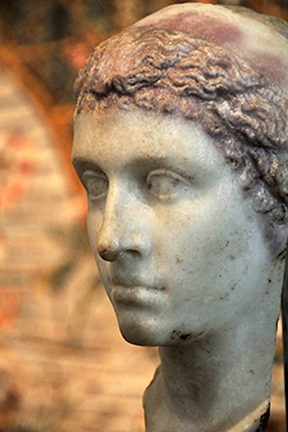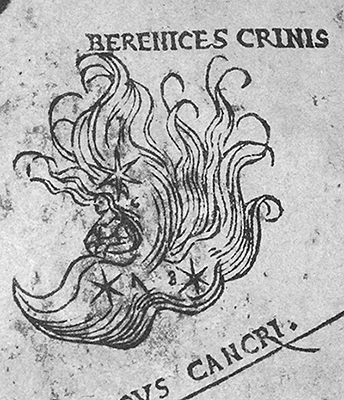"For she was a woman of surpassing beauty, and at that time, when she was in the prime of her youth, she was most striking; she also possessed a most charming voice and a knowledge of how to make herself agreeable to every one. Being brilliant to look upon and to listen to, with the power to subjugate every one, even a love-sated man already past his prime, she thought that it would be in keeping with her rôle to meet Caesar, and she reposed in her beauty all her claims to the throne. She asked therefore for admission to his presence, and on obtaining permission adorned and beautified herself so as to appear before him in the most majestic and at the same time pity-inspiring guise. When she had perfected her schemes she entered the city (for she had been living outside of it), and by night without Ptolemy's knowledge went into the palace."
Dio, Roman History (XLII.34.4-6)
As to Cleopatra's size, the only hint comes from Plutarch's famous description of her being smuggled into the palace bundled in an oversized sack one autumn night in 48 BC—which argues that at least she was petite. "It was by this device of Cleopatra's, it is said, that Caesar was first captivated, for she showed herself to be a bold coquette" (Life of Julius Caesar, XLIX.3). And it was there that the young Ptolemy XIII found them early the next morning, aghast that Caesar already had been seduced by his half-sister. Nine months later, her son Caesarian was born.
Cleopatra was about twenty-one years old at the time. Seven years later, in 41 BC, she met Antony at Tarsus on the river Cydnus, confident that, once again, she could allay the suspicions of an imperious Roman (indeed, it was then that she conceived her twin children by him). Plutarch records that
"judging by the proofs which she had had before this of the effect of her beauty upon Caius Caesar and Gnaeus the son of Pompey, she had hopes that she would more easily bring Antony to her feet. For Caesar and Pompey had known her when she was still a girl and inexperienced in affairs, but she was going to visit Antony at the very time when women have the most brilliant beauty and are at the acme of intellectual power. Therefore...she went putting her greatest confidence in herself, and in the charms and sorceries of her own person" (Life of Antony, XXV.3–4).
And yet, it is a later passage, where the praise is more faint, that is cited when the queen's appearance is disparaged.
"For her beauty, as we are told, was in itself not altogether incomparable, nor such as to strike those who saw her; but converse with her had an irresistible charm, and her presence, combined with the persuasiveness of her discourse and the character which was somehow diffused about her behaviour towards others, had something stimulating about it. There was sweetness also in the tones of her voice; and her tongue, like an instrument of many strings, she could readily turn to whatever language she pleased" (XXVII.2–3).
Plutarch remarks that the Romans pitied Antony for having callously evicted his dutiful wife Octavia from their house, "especially those who had seen Cleopatra and knew that neither in youthfulness nor beauty was she superior to Octavia" (LVII.3). But here, he seems to have confused Octavia minor (Antony's wife) with Octavia major, Octavian's older half sister of the same name—or failed to realize that there even were two sisters (Suetonius, Life of Augustus, IV.1). In fact, both Cleopatra and the younger Octavia were the same age. He does criticize the queen when she refused to have Antony killed or given up, as "a woman who was haughty and astonishingly proud in the matter of beauty" (Life of Antony, LXXIII.1) but is forced to admit, in a final comment on Cleopatra's appearance, that, even in mourning for her dead lover, her charm and "the boldness of her beauty were not altogether extinguished" (LXXXIII.2).
Florus, too, comments on "the beauty of the damsel, which was enhanced by the fact that, being so fair, she seemed to have been wronged" (II.13.56). Appian remarks on the "beautiful image of Cleopatra by the side of the goddess" (II.102) in the Temple of Venus Genetrix, and Antony being "amazed at her wit as well as her good looks" (V.1.8). Cicero, who could have provided a contemporary description when Cleopatra was in Rome, does not mention her appearance. Writing three months after the assassination of Caesar and with the queen safely away from Rome and back in Alexandria, he instead vents his indignation at her arrogance, petulantly complaining that he did not receive a promised gift from her (Letters to Atticus, XV.15).
Reviled by the Augustan poets and vilified as a foreign seductress, Cleopatra was called a meretrix regina, "whore queen" by (Propertius, Poems, III.11.39; Pliny uses the same phrase, (Natural History, IX.58.119); a "fatal monster" by Horace (Odes, I.37.21); and "Egypt's shame" by Lucan (Pharsalia, X.59). If she truly had not been attractive, one suspects that her detractors would have said so. On the contrary, Lucan repeatedly refers to her beauty, even as she is criticized for it. Just as Helen's "harmful beauty" had brought ruin to Troy so did that of Cleopatra inflame Rome's civil war (X.61). It is her appearance (forma) that she relies upon in pleading her case to Caesar (X.82), simulating grief but without tears so as to remain attractive (X.84) and allowing her "impure beauty" to aid her entreaty (X.105). Later, there is an extravagant banquet, where the "harmful beauty" (X.138) of the queen again is exhibited—this time, she is daubed in make-up, weighted down with a fortune in pearls around her neck and jewels in her hair, and her white breasts visible beneath the sheer fabric of her oriental dress (X.139ff).
The so-called "Berlin Cleopatra" shown above likely is of Italian provenance and may have been made when Cleopatra was in Rome. Or the bust may have been the work of an Alexandrian sculptor and brought with her. She wears the royal diadem, a broad ribbon of cloth tied around the hair that first had been worn by Alexander the Great and came to symbolize Hellenistic kingship. Small ringlets frame the brow, although later restoration has blurred the features of the original. The purple stain to the hair also may have been the result of misguided conservation.
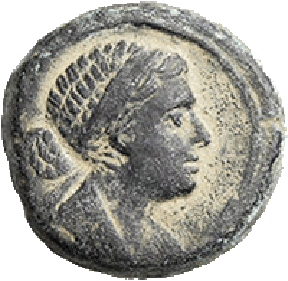
Struck at Alexandria early in her reign (after 51 BC), when Cleopatra was eighteen years old and, as Dio phrased it, "in the prime of her youth," this portrait, Hellenistic in style, shows a graceful profile with full cheeks, straight nose, short neck, and small chin—features that closely match her portrait busts. She was the only Ptolemaic queen to mint coins with her own name and effigy (in which she alone is portrayed), and the die cutters presumably knew her appearance.
The coin is a bronze eighty-drachma, on the reverse of which is the incused inscription KLEOPATRAS BASILISSES ("of Queen Cleopatra"). An eagle clutches a thunderbolt and is flanked by a double cornucopia and a denominational mark, the letter Π (pi), which in Greek isopsephism corresponded to eighty. It was an innovation that allowed the royal mint to assign an official denomination to a coin not otherwise related to its intrinsic value.
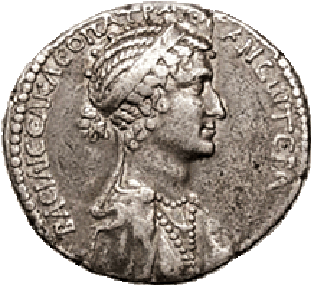
This silver tetradrachm, which was struck in Antioch sometime after 37 BC, presents an altogether different image. Cleopatra then was about thirty-two years old and Antony, if not married to the queen, had acknowledged her two children by him. Although it does not have the wear that usually distorts the portrait of the queen, the depiction is not necessarily accurate. More Roman in style, it follows an artistic convention that the wife assimilate the appearance of her husband to better suggest their mutual harmony. Cleopatra therefore displays the same hooked nose and prominent chin as Antony, whose own features are even more exaggerated on the obverse (cf. Plutarch, Life of Antony, IV.1, where his aquiline nose was thought to show the virile qualities particular to Hercules, from whom he claimed descent).
Cleopatra is shown wearing the royal diadem and a magnificent pearl necklace, her hair braided in a characteristic "melon" hairstyle. Divided into sections (like the markings of a melon) and pulled back into a bun wound at the nape of the neck, space is left above the forehead for short curly bangs. The style appears in the portraits of two third-century BC Ptolemaic queens, Arsinoë II and Berenice II, and was worn by Cleopatra to evoke those illustrious ancestors. (All the Ptolemaic women, in fact, were named either Arsinoë, Berenice, or Cleopatra.) The elaborate coiffure likely was introduced to Rome by her visit there in 46–44 BC but stigmatized after the defeat of Antony and Cleopatra at Actium in 31 BC. A more austere and modest hairstyle then was adopted, one consistent with the conservative republic and the modest image of women dictated by the new moralism of Augustus.
The first-century BC marble bust is one of the few other portraits thought to represent the queen (and identified as such in 1933). Found at the Villa dei Quintilii on the Via Appia in 1784, it has the broad band of the diadem and possibly is a Roman copy of the gilded bronze statue of Cleopatra in the Temple of Venus Genetrix, the first time that an image of an individual had been placed next to that of a goddess (Appian, The Civil Wars, II.102; Dio, Roman History, LI.22.3). The knot (nodus) on her head may be the remnant of a crown or some other attribute, or even a knotted lock of hair. The nose is missing, which makes it difficult to judge the beauty of the queen.
In the Pensées, Pascal remarks that "Cleopatra's nose, had it been shorter, the whole face of the world would have been changed" (180). What he means is that, had her nose been smaller, she would have lacked the dominance and strength of character which, in the physiognomy of the seventeenth century (or, indeed, the nineteenth), a large nose symbolized. It is a salutary reminder that the aesthetics of beauty change over time and place. Rather than ask whether Cleopatra was beautiful, which cannot be answered in any event, the question should be whether she was desirable.
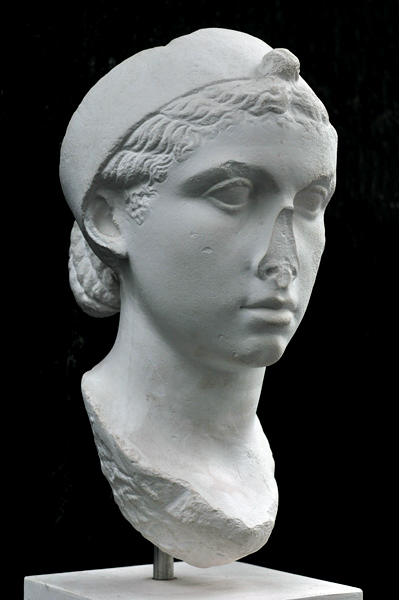

The plaster cast of the Vatican Cleopatra, which was taken in the Staatliche Antikensammlungen (Berlin), shows the queen to good effect and may have been sculpted when she was in Rome. Here, one can appreciate how young Cleopatra was when she first met Caesar in 48 BC. He then was more than thirty years her senior and to stay in Egypt until the next year, when she gave birth to Caesarion ("little Caesar"). That year too, her brother drowned in the Nile during the Alexandrian War and Cleopatra became sole ruler. She then duly married her other younger brother (Ptolemy XIV) but he died at her instigation in 44 BC, just months after Caesar himself had been assassinated. Caesarian then became nominal ruler as Ptolemy XV, the last of that royal lineage, until his own death in 30 BC, just days after that of his mother.
The original bust is relegated to a corner of the Museo Gregoriano Profano, which then was closed to the public because there was not the staff to supervise it. After repeated visits, a sympathetic guard did allow supervised access for this photograph to be taken. Its placement against a back wall in front of a window does not present the queen to advantage, as can be seen from the weathered left cheek.
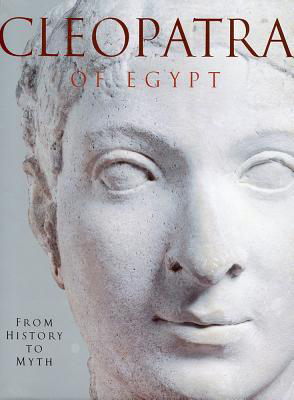
"The nobleness of life is to do thus...We stand up peerless."
(Shakespeare, Antony and Cleopatra, I.1).
The British Museum catalog of its 2001 exhibition Cleopatra of Egypt: From History to Myth does not have either the Berlin or Vatican bust of Cleopatra on its cover but that of a woman, perhaps a member of her entourage, who may have modeled herself after the queen. Although there are similarities that initially led to it being identifying as that of Cleopatra—including the strong aquiline nose, curved nostrils, and pointed chin—the hair style is more elaborate and differs from the other portrait heads. More telling, there is no royal diadem.
The Castellani head (after its former owner) is in the British Museum and dates from 50–30 BC. It was the first bust to be identified as Cleopatra based on numismatic evidence, which may account for it gracing the cover of the catalog. Or the curators simply may have thought that it presented a more pleasing and complete portrait—and more readily at hand. (In preparing the exhibit, a small black basalt statue on loan from the Hermitage Museum also was identified as depicting Cleopatra.)
"Not Berenice's locks first rose so bright,
The heav'ns bespangling with dishevell'd light."Alexander Pope, Rape of the Lock
Hyginus relates the story of Berenice's lock of hair in the Astronomica (II.24). In 245 BC, shortly after the marriage of Ptolemy III to Berenice II, he set out on campaign to Syria, his wife dedicating a lock of her hair for his safe return. Dutifully cut and placed in the temple, the votive offering disappeared the next day. The court astronomer explained to the distressed king that the lock of hair (crinis) had been placed in the heavens, the faint cluster appearing as "seven stars without definite configuration which he imagined were the lock" (Coma Berenices).
Callimachus, poet and scholar at the Library of Alexandria who enjoyed the patronage of the king, wrote a poem for Berenice commemorating the catasterism of her scented lock (its transformation into a star or constellation), which was carried off by Zephyrus at the command of Aphrodite. Although only a fragment survives (Aetia, 110–110f), it was translated by Catullus and is his best-known poem (LXVI). Berenice herself appears among her tresses in the image above, which is from a printed celestial globe of 1536 by Caspar Vopel, the first representation of the new constellation that originally had been considered to be the tuft of Leo's tail.
If reviled in Rome, Cleopatra did find favor in the East, where Zenobia of Palmyra boasted she "herself to be of the family of the Cleopatras and the Ptolemies" (Historia Augusta, The Thirty Pretenders, XXX.1) and no more ready to surrender in her defiance of Rome than Cleopatra (Aurelian, XXVII.2). Even late in the seventh century AD, John Bishop of Nikiu praised Cleopatra, not only as "a very beautiful young girl" (Chronicle, LXIV.7) but "the most illustrious and wise amongst women" (LXVII.9). (He also considered Hypatia to have been devoted to "magic, astrolabes and instruments of music" and beguiling people with her satanic wiles, LXXXIV.87.) In 1361, Boccaccio could dismiss the queen as "famous for nothing but her beauty" (De Mulieribus Claris).
The Berlin Cleopatra, which was acquired only in 1976, and the plaster cast of the Vatican Cleopatra are in the Staatliche Antikensammlungen (Berlin). The tetradrachm is from Freeman & Sear, Fixed Price List 12 (Winter 2007), Item 115; the eighty-drachma from Heritage Auctions, World & Ancient Coins Signature Auction (April 19, 2013), Lot 24708. The image of Berenices Crinis is from the Kölnische Stadtmuseum (Cologne).
References: Plutarch's Parallel Lives (1916) translated by B. Perrin (Loeb Classical Library); Dio Cassius: Roman History (1916) translated by Earnest Cary and Herbert B. Foster (Loeb Classical Library); Appian: The Civil Wars (1913) translated by Horace White (Loeb Classical Library); Cicero: Letters to Atticus (1999) translated by D. R. Shackleton Bailey (Loeb Classical Library); Florus: Epitome of Roman History (1929) translated by Edward Seymour Forster (Loeb Classical Library); Lucan: Civil War (1992) translated by Susan H. Braund (World's Classics); The Myths of Hyginus (1960) translated by Mary Grant; Callimachus: Aetia (2012) edited by Annette Harder; "XVII.–The Problem of Octavia Minor and Octavia Maior" (1948) by Mary White Singer, Transactions and Proceedings of the American Philological Association, 79, 268-274.
Cleopatra of Egypt: From History to Myth (2001) edited by Susan Walker and Peter Higgs; "Meretrix Regina: Augustan Cleoptras" by Maria Wyke, in Augustus (2009) edited by Jonathan Edmondson; Cleopatra and Rome (2005) by Diana E. E. Kleiner; Cleopatra Reassessed (2003) edited by Susan Walker and Sally-Ann Ashton (British Museum, Occasional Paper No. 103); "Caspar Vopel's Ventures in Sixteenth-Century Celestial Cartography" (2010) by Elly Dekker, Imago Mundi, 62(pt. 2), 161-190; "Berenice and Her Lock" (2011) by Dee L. Clayman, Transactions of the American Philological Association, 141(2), 229-246; "Callimachus' Lock of Berenice: Fantasy, Romance, and Propaganda' (1992) by Kathryn Gutzwiller, The American Journal of Philology, 113(3), 359-385.
